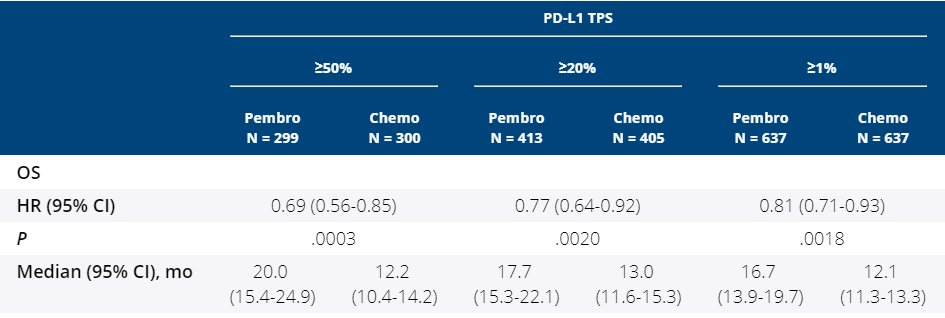


Locally advanced non–small cell lung cancer (NSCLC) accounts for 20% to 25% of new diagnoses of NSCLC.

Keynote 042 registration#
Trial Registration Identifier: NCT02621398 Median PFS for patients who received at least 2 doses of pembrolizumab (n = 19) was 21.0 (95% CI, 15.3 to infinity) months.Ĭonclusions and Relevance These findings suggest that combined treatment with PD-1 inhibitors and chemoradiotherapy for stage III NSCLC is tolerable, with promising PFS of 69.7% at 12 months, and requires further study. Immune-related adverse events of at least grade 3 occurred in 4 patients (18%). One case of grade 5 pneumonitis occurred in the safety expansion cohort with the cohort 5 regimen. Results Among the 21 patients included in the analysis (11 female median age, 69.5 years), no dose-limiting toxic effects in any cohort were observed. Secondary outcomes included PFS and pneumonitis rates. Main Outcomes and Measures Safety and tolerability of PD-1 inhibition with chemoradiotherapy for NSCLC. Dose-limiting toxic effects were defined as pneumonitis of at least grade 4 within cycle 1 of pembrolizumab treatment. A safety expansion cohort of 6 patients was planned based on the maximum tolerated dose of pembrolizumab. Dose cohorts evaluated included full-dose pembrolizumab (200 mg intravenously every 3 weeks) 2 to 6 weeks after chemoradiotherapy (cohort 1) reduced-dose pembrolizumab (100 mg intravenously every 3 weeks) starting day 29 of chemoradiotherapy (cohort 2) full-dose pembrolizumab starting day 29 of chemoradiotherapy (cohort 3) reduced-dose pembrolizumab starting day 1 of chemoradiotherapy (cohort 4) and full-dose pembrolizumab starting day 1 of chemoradiotherapy (cohort 5). Interventions Pembrolizumab was combined with concurrent chemoradiotherapy (weekly carboplatin and paclitaxel with 60 Gy of radiation in 2 Gy per d). Data were analyzed from October 17, 2016, to July 19, 2019. Twenty-one participants had locally advanced, unresectable, stage III NSCLC as determined by multidisciplinary review, Eastern Cooperative Oncology Group performance status 0 or 1, and adequate hematologic, renal, and hepatic function.
Keynote 042 plus#
Objective To determine the safety and tolerability of PD-1 inhibition concurrently with definitive chemoradiotherapy for NSCLC.ĭesign, Setting, and Participants This phase 1 prospective multicenter nonrandomized controlled trial using a 3 plus 3 design was performed from August 30, 2016, to October 24, 2018, with a median follow-up of 16.0 (95% CI, 12.0-22.6) months and data locked on July 25, 2019. Importance Consolidative programmed death ligand-1 (PD-L) inhibition after chemoradiotherapy improves overall survival and progression-free survival (PFS) for stage III non–small cell lung cancer (NSCLC) and requires safety evaluation for incorporation of programmed cell death 1 (PD-1) inhibition at the onset of chemoradiotherapy. Shared Decision Making and Communication.Scientific Discovery and the Future of Medicine.Health Care Economics, Insurance, Payment.Clinical Implications of Basic Neuroscience.Challenges in Clinical Electrocardiography.


 0 kommentar(er)
0 kommentar(er)
